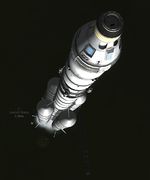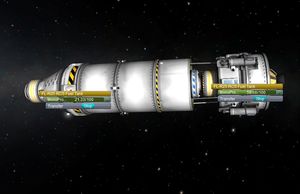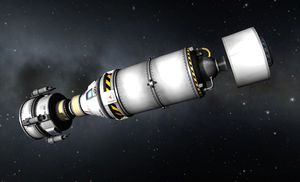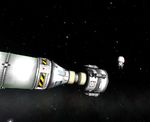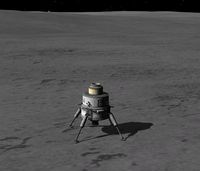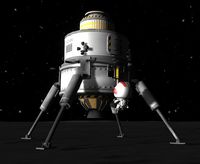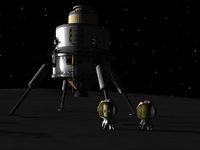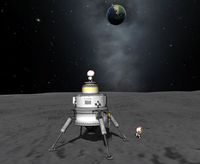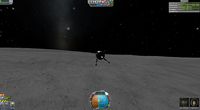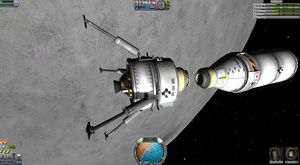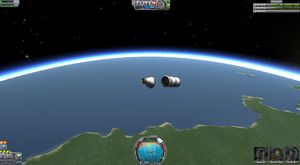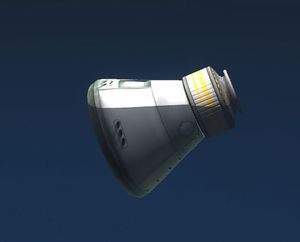Difference between revisions of "Tutorial: Apollo 11/ko"
Ysjbserver (talk | contribs) (→Return to Kerbin) |
Ysjbserver (talk | contribs) (→Start and Redocking) |
||
| Line 122: | Line 122: | ||
[[File:Apollo-small-step.jpg|200px|successful landing]] [[File:Apollo-posing.jpg|200px|successful landing]] [[File:Apollo-looking-at-kerbin.jpg|200px|successful landing]] | [[File:Apollo-small-step.jpg|200px|successful landing]] [[File:Apollo-posing.jpg|200px|successful landing]] [[File:Apollo-looking-at-kerbin.jpg|200px|successful landing]] | ||
| − | === | + | === 이륙과 재도킹 === |
When you explored the landing area properly it's time to return home. Get your crew back into the lander and retract the ladder. Check the position of the service module and wait until it appears at the horizon. Then start. | When you explored the landing area properly it's time to return home. Get your crew back into the lander and retract the ladder. Check the position of the service module and wait until it appears at the horizon. Then start. | ||
Revision as of 14:06, 16 February 2014
이 페이지는 아직 번역이 완료되지 않았습니다
| “ | 나는 황홀하고 우리가 성공해서 매우 놀랐습니다. — 닐 암스트롱, 그가 달에 착륙하고 느낀 점의 설명 |
” |
우리는 마침내 다른 천체의 첫 번째 유인 착륙을 할 것입니다. 이 임무 동안 우리의 도킹 및 EVA 노하우가 모두 필요합니다. 제미니 6호와 7호 미션뿐만 아니라, 우리는 루나 9호 미션에서 달 착륙에 대해서 배웠습니다.
아폴로 프로그램의 여섯 번의 달 착륙은 역사에 있는 다른 천체에 인간의 첫 번째이자 유일한 착륙입니다. 그것은 아마도 세계 역사상 가장 큰 엔지니어링 프로젝트였습니다. 40만 명 이상의 사람들이 프로젝트에 참여했습니다. 전체 비용은 250억 이상의 미국 달러로 추정됩니다(인플레이션을 막기 위한 오늘날 쓰여지는 미국 달러는 120억 달러입니다). 대부분은 인간의 우주 비행의 절정입니다. 그러나 인간 진화의 전체를 고려해야 합니다,우리가 우리의 지구를 떠나는 것이 기술적으로 할 수 있는 것으로 나타났습니다. 슬프게도, 지구 궤도 외의 인간의 우주 비행은 지난 40년 동안 없었습니다.
Contents
선체 구조
이 임무를 위해 우리는 지금까지 만들어진 가장 크고 가장 강력한 로켓을 다시 만듭니다:새턴 5호 로캣. 우리는 KSP가 제공하는 전체 높이 제한까지 로켓을 만듭니다-그것은 우주선 조립 건물의 천장에 닿을만큼 큰 것입니다.
다만 우리의 페이로드는 실제 아폴로 임무와 같은:사령선 및 서비스 모듈(CSM) 도킹된 착륙선(LM).그냥 실제 아폴로 임무처럼 우리는 시작하는 동안 서비스 모듈 뒤에 착륙 모듈을 넣어 둘 것입니다, 그리고 비행 동안 착륙선의 앞에 이동합니다.
- 사령선
- 1x Clamp-O-Tron Docking Port
- 1x FL-R25 RCS Fuel Tank
- 1x Mk1-2 Command Pod (1차 명령 모듈)
- 2x Mk2-R Radial-Mount Parachute
- 서비스 모듈
- 1x Rockomax Brand Decoupler
- 1x Rockomax X200-32 Fuel Tank
- 4x RV-105 RCS Thruster Block (착륙선 없이 서비스 모듈의 질량 중심에 정확하게 그들을 배치해야 합니다)
- 1x Rockomax "Poodle" Liquid Engine
- 착륙선
- 1x TR-2C Stack Separator
- 1x Clamp-O-Tron Docking Port
- 1x FL-R25 RCS Fuel Tank
- 1x Mk2 Lander-can (2차 포드, 발사될때 무인이어야 합니다)
- 4x EAS-4 Strut Connector (착륙선-CAN 및 서비스 모듈의 연료 탱크 사이. 해치를 방해하지 않도록 주의!)
- 4x RV-105 RCS Thruster Block
- 1x Rockomax X200-8 Fuel Tank
- 1x Telus Mobility Enhancer (문 아래의 미니 사다리 아래에 배치)
- 4x LT-2 Landing Strut
- 1x LV-909 Liquid Fuel Engine
- 3단계
- 1x TR-18A Stack Decoupler
- 2x Rockomax X200-32 Fuel Tank
- 4x EAS-4 Strut Connector (상단의 연료 탱크와 착륙선의 연료 탱크 사이)
- 1x Rockomax "Mainsail" Liquid Engine
- 2단계
- 1x Rockomax Brand Decoupler
- 10x Rockomax X200-32 Fuel Tank (중앙의 두 개의 스택 중 하나는 그것의 주위에 방사상으로 장착)
- 24x EAS-4 Strut Connector (중앙 탱크에 두 개의 수평 이웃에 외부 탱크의 각을 연결-그림 참고)
- 4x Protective Rocket Nose Mk7
- 4x EAS-4 Strut Connector (3단계의 하부에 연료 탱크 각각 링크)
- 4x RV-105 RCS Thruster Block (가능한 한 낮게 배치)
- 5x Rockomax "Mainsail" Liquid Engine
- 1단계
- 5x Rockomax Brand Decoupler
- 15x Rockomax X200-32 Fuel Tank (3개의 스택이 센터에 있고 4개의 스택은 상기 스테이지의 외측에 장착, 절대로스테이지 중앙에 넣지 않는다)
- 36x EAS-4 Strut Connector (중앙 탱크에 두 개의 수평 이웃에 외부 탱크의 각을 연결 - 그림 참고)
- 8x Standard Canard
- 5x Rockomax "Mainsail" Liquid Engine
마지막 다섯 엔진에 거의 여지가 없을 것입니다. 그들은 VAB의 바닥을 통해 클립합니다. 하지만 런치 패드에 로켓을 넣었을 때, 그들은 접지 위에서 고정될 것입니다, 걱정하지 마십시오.
당신이 모두 완료되면,전체 모양을 두 번 확인하십시오. 착륙선의 엔진이 서비스 모듈의 엔진 후에 활성화되야합니다.
임무 계획
전이궤도로 진입하기
Use the first two stages to get into orbit and the third to circularize it and get into a Mün transfer orbit just like you did for Luna 9. Do this with using as little monopropellant as possible because you will need it for the docking maneuvers later. To make sure that you don't accidentally use up all the monopropellant, deactivate one of the two tanks before the launch (right-click it and then click the green arrow to turn it into a denied-sign).
You can control stage 1 with only the canards and - thanks to engine gimbal - stages one and two also behave well without RCS thrusters as long as they (the engines) are on, so you'll only need RCS to correct your bearing while the engines are off.
When you want to go for maximum authenticity, go for a free return trajectory.
Reorganizing the modules
Now begins the tricky part of the mission. Just like it was done on the real Apollo missions, we placed the landing module right under the main engine of the command and service module. Before we can use the engine we need to get the LM on the other end of the CSM.
- Drop the third stage
- Make sure that the ship is perfectly still and not rotating, this can be achieved by pressing 't' to activate reaction wheels.
- make sure that both LM and CSM have monopropellant. Pump some around when necessary.
- decouple the docking node between LM and CSM. Do not use the stack separator!
- thrust just a tiny bit forward with the RCS thrusters of the CSM and stop the movement after about a meter with a backwards RCS trust
- set the LM docking port as your target
- turn the CSM by exactly 180°. I recommend to do this while SAS and the RCS thrusters are switched off. This is slower, but you avoid any unwanted movement in case the RCS thrusters aren't exactly on the center of mass.
- thrust forward to redock the LM at the top docking node
- engage the stack decoupler at the bottom of the service module. (By the way: the sole function of this separator was to hold the cover around the engine. Without it it would have stayed on the docking port of the LM and would have blocked your view during the docking maneuvers)
Transferring the landing crew
During the real Apollo missions the crew could board the landing module through the docking hatch. Unfortunately the current version of KSP (0.21) doesn't allow that, so we need to do two EVAs to transfer the crew. Let the first Kerbonaut leave the command pod, fly to the door of the lander can, and enter it. Then do the same with the second Kerobonaut. The third one stays behind in the CSM to control it while in Mün orbit and when redocking the CSM.
Enter Mün orbit
Get into an orbit with a height of about 20km around the Mün. Make it as circular as possible. This will make the later redocking easier.
The Landing
You have already completed the tricky part, now begins the insanely tricky part: the landing.
- Click on the docking port of the landing stage and select "control from here" so you gain control of the lander right after the separation
- Undock the landing stage
- Deploy the landing gear so you don't forget about it
- Boost retrograde to get into a suborbital trajectory, preferably one which leads you to a landing area on the day side with a nice view of Kerbin (try to do it without ramming the service module)
- wait until you descended to a height of 10km
- follow the same rule you followed with the Luna probe: boost so your ground speed = your altitude / 100. Note that although your lander *has* RCS thrusters and fuel, you should do the landing without them. The torque from the lander-can is more than enough. You need the thrusters for redocking with the CSM later.
- get down as vertical as possible. Your landing gear can withstand an impact of up to 12 m/s, but try to stay under that so you have some security tolerance.
- let it sink to the ground
- you can continue breathing now
Congratulations, the eagle has landed.
Now get your Kerbonaut out of your lander can, say something quotable about small steps and giant leaps, and jump to the ground. Plant your flag, take some screenshots and videos for future generations, and make sure they are labelled properly, so nobody tapes them over like it happened at a certain other space administration[1].
이륙과 재도킹
When you explored the landing area properly it's time to return home. Get your crew back into the lander and retract the ladder. Check the position of the service module and wait until it appears at the horizon. Then start.
Unlike Kerbin the Mün has no atmosphere, which makes a start considerably easier. You don't have to start vertically and fix your orbital speed after you are out of the atmosphere. You can head east or west (depending on the orbital direction of your command module) after you gained enough height so as to not collide with any hills or crater walls. Just make sure that the yellow heading marker always stays above the horizon. Get into an orbit identical to the CSM and perform docking just like you did during the Gemini tutorial.
커빈 귀환
Get the two kerbonauts from the lander back into the command module. Then drop the lander. Use the remaining fuel of the CSM to leave the Mün orbit in a direction retrograde to the orbit of Mün around Kerbin. When your orbital direction around Mün is prograde (90°, anticlockwise), accelerate when you are closest to Kerbin. When you are retrograde (270°, clockwise) accelerate when you are facing retrograde relative to Kerbin, but prograde relative to the Mun. Keep accelerating until your trajectory hits Kerbin.
Wait until you are in Kerbin's atmosphere, then drop the service module, activate the parachutes of the command module, and drop gently into the ocean. Mission successful!
What now?
When you want to have some more fun with this ship, you could simulate the "successful failure" Apollo 13. During this moon landing mission the service module became unusable due to a technical defect, so that the crew had to cancel the landing on the moon and return to earth using the thruster and fuel of the landing module.
Play the mission normally until after you moved the landing module on top of the command module. Then "accidentally" activate the stack separator between the command and service module. Try to get back to Kerbin with only the CM and LM by using the thrusters and fuel of the LM.

